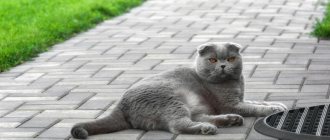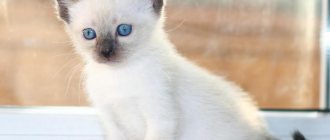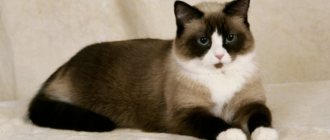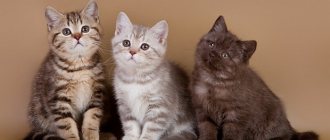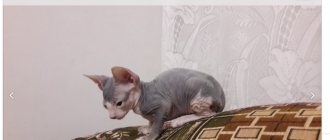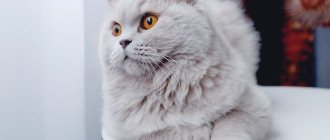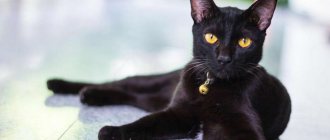In scenes of family life, the Egyptians placed a cat under a stool so that the woman would have many children in the future. These images indicate 15th century. BC a cat with kittens already lived in the house. The British cat breed was officially recognized much later, in the 19th century. In Great Britain, furry animals with aristocratic manners are national pride. British kittens refute the idea that pets of the same name are unfriendly. Babies with thick fur coats look like a plush toy. They are very willing to support games with children and spend time actively. When bringing a fluffy British kitten home, you should not forget: the life, health, and comfort of the ward depend on knowledge of the characteristics of the breed and care.
Birth
In general, cat pregnancy lasts about 56-63 days. The period depends on the breed for many other reasons. It is impossible to say exactly how long cats are pregnant or how long gestation lasts. Factors influencing duration:
- Weight.
- Presence of previous attacks.
- The relationship between the time of the first estrus and mating.
It is advised to breed a female cat on her third heat, trying to avoid protracted previous periods. If the pet is taken to a partner earlier, the animal will bear kittens for about 50 days. The babies may appear premature or dead.
The weight of the pet is also important when determining the timing of the cat's death. Small beauties, weighing about 3 kg, bear kittens faster, how long do small British cats walk before permission is known. Cubs appear earlier, at 55-56 days. Large adult, sedentary individuals migrate at 64-65 days and can walk beyond the established period.
How many kittens an animal gives birth to depends on the time at which the process occurs; a British cat brings no more than three babies for the first time. Typically, primiparous cats are delivered on time at 63 days. Labor lasts approximately 2 to 14 hours.
It often happens that there is only one kitten in the first litter. And this is from mating with a pet, which can produce up to 7-8 babies. There is no need to be afraid and try to stimulate the appearance of more: each animal’s body has its own characteristics. It is not so important the number of litters a cat produces from the first time, and how many kittens the British favorite will give birth to. You need to worry about the condition of the animal and its offspring.
When to start - tips
Small pets should not be taken away from their mother too early. The main reason for this rule: the baby must be fed breast milk and will learn hygiene skills from an adult cat. The optimal age for moving to another family is 3 months, the cub will be about 12 weeks old.
Smell and touch are the main helpers of a kitten in the first days of birth. The baby does not hear or see yet: he finds his mother’s warm side and nipple by smell. The organs of vision begin to function 10-14 days after lambing. In many ways, the opening of the eyes depends on gestation, that is, on how long the cat carried the kitten. Premature babies will develop the ability to see later. Those born later will see the world faster.
The development of female pets is more intensive. The girl's eye slits become wider earlier than those of her furry brothers. The breed of the animal also matters. British Shorthairs will open their eyes on the 6th day after birth. And for long-haired breeds, the process of restoring visual activity can take up to 14 days.
In a dark place, the formation of the ability to see will take longer. The deadline has passed, but the baby is still blind. You can help him to open his eyes faster. On the advice of veterinarians, an antibacterial medicine is instilled and the eyes are washed with strong tea and a solution of boric acid.
Regardless of the breed, all babies, including British newborns, have blue-gray eye color. The shell will acquire its characteristic final shade only after 6 months. When kittens open their eyes after 6 days of birth, the habits of the inquisitive baby change.
The kitten's first days at home
It is important not to forget the simple rules for adapting a pet to your home. The little creature is scared, the animal was taken away from its mother and placed in an unfamiliar environment. New smells, sounds, food - absolutely everything is foreign to the plush ball. Necessary steps to acclimate a tiny family member:
- Separate a small room for the pet. There is no need to immediately leave the baby in a large apartment. Let it be a bathroom or a corridor. Later, as you adapt, you can open the doors to other rooms.
- By purchasing an animal from an experienced breeder, you get a pet that is accustomed to grooming skills. By 2-3 months the child already knows how to go to the toilet and litter tray. A napkin with the kitten’s urine is placed in the container: the baby will orient itself by the smell and quickly get used to the place. If the cat has stepped on upholstered furniture or carpet, the stain is immediately wiped away. Otherwise, there is a chance that the fidget will continue to shit anywhere.
- There is no need to shower your baby with toys, even those specially purchased for him in pet stores. Children are not allowed to grab, pull, or squeeze a purebred pet.
- It happens that the kitchen and toilet are located far from each other. To begin with, you can place feeding dishes next to the tray.
- They talk to the pet and call it by name.
- Fluffy is gradually accustomed to food.
Limits of normal, underweight and overweight cats of popular breeds (tables)
To determine whether an animal is of normal weight or not, sometimes just looking at it is enough, especially if it is short-haired. The stomach of a cat with a deficiency of body weight is sunken, the ribs, pelvic bones, articulations of the ribs with the thoracic vertebrae and the spine protrude, the muscle and fat layers are practically absent.
Obesity in a cat
An obese pet has a large belly without a hint of a waist and a large muzzle. The bones cannot be felt behind a thick layer of fat.
Adult pets
| Kitten age | Weight, g/kg | |||
| Cat | Cat | |||
| Newborn | 60—140 | 70—140 | ||
| 1 Week | 110—250 | 240—260 | ||
| 2 | 150—360 | 340—400 | ||
| 3 | 210—420 | 400—630 | ||
| 4 | 250—600 | 550—740 | ||
| 5—9 | 450—900 | 1,0—1,7 | ||
| 10—14 | 1,0—1,5 | 1,5—2,5 | ||
| 15—18 | 1,7—2,4 | 2,1—3,9 | ||
| 19—23 | 2,2—2,9 | 2,6—4,3 | ||
| 24—28 | 2,3—3,6 | 3,0—5,4 | ||
| 7 months | 2,4—3,9 | 3,3—5,6 | ||
| 8 | 2,5—4,1 | 3,5—6,0 | ||
| 9 | 2,5—4,3 | 3,8—6,4 | ||
| 10 | 2,5—4,4 | 4,1—6,7 | ||
| 11 | 2,5—4,5 | 4,3—6,8 | ||
| 1 year | 2,5—4,6 | 4,5—7,0 | ||
| Adults | 2,5—5,5 | 4,5—8,0 | ||
| Neutered/neutered | 2,5—6,0 | 4,5—9,5 | ||
Caring for British kittens
The mother will teach the baby the first hygiene skills. Further, taking care of the appearance and health of the baby rests with family members.
Necessary procedures:
- Cleansing ears and eyes. The condition of the hearing and vision organs is monitored weekly: they are cleaned of dirt and pus. Why British kittens have watery eyes up to 5 months old and how to help them, a doctor at any veterinary clinic will explain. With the process of improving the respiratory system, this unpleasant phenomenon disappears. You should blot your eyes with moistened cotton swabs.
- Combing the fur coat. During the cold season, babies are brushed every week. In summer as needed. Purchase a special metal comb for combing out wool and undercoat. Kittens and older pets usually enjoy the procedure. There is not always time for combing: they find an arch comb. The cat will come up to the arc and scratch its fur.
- Manicure. It is not necessary to take it to the salon; the owner will be able to carefully, carefully, trying not to injure the animal, trim the claw. Start with nail care from 3 months, repeat once every 2 weeks. You need to pick up miniature scissors.
- Bathing the pet. Water procedures are resorted to as the British fur gets dirty. Anti-parasitic agents are also washed off from the hair after treatment. Not all babies love water; sometimes you can get by with dry shampoo.
What to buy
It is necessary to prepare for the arrival of your pet in advance. List of necessary things:
- litter tray, device with low sides. In the future, you can change it to a deeper container so that the cat does not scatter the litter throughout the house;
- scratches, a scratching post is necessary for both the cat and the owner. To prevent the baby from ruining the surface of the furniture, they teach him how to use the item. They sell cool designs with balls;
- toys, for the development and prevention of obesity, the pet needs to actively move: balls, mice, houses with hanging balls, hammocks.
- utensils for eating and drinking.
What to feed
Food from the family table is not suitable for your pet. There is not much information on what to feed small British kittens. Contrary to popular belief, cats should not be fed fish 7 times a week. A photo of a British kitten by month shows the growth and external changes of the baby.
There are also age restrictions on the baby menu. What is the best way to feed a British kitten:
- lean boiled meats, exclude pork;
- cottage cheese, kefir and sour cream;
- boiled vegetables;
- cereals;
- boiled fish: no more than once a week.
What to feed 1st month
The kitten will be satisfied with its mother's milk for up to a month. At the beginning of the 4th week, the cat’s food dishes should be placed next to the cat’s bed. Babies will be attracted by the smell of food, then you can gradually introduce complementary foods: once a day. They give natural products or wet specialized food for kittens. The crumbs easily cope with food, bringing the food to 3-5 rubles per day. Growth and weight gain are monitored simultaneously: the kitten’s weight should correspond to the age norm. At 6 weeks the animal usually stops drinking cat milk.
What to feed 2nd month
At home, conditions of detention are not always followed, but you need to know what to feed a British kitten at 2 months. Babies at 2 months finally refuse mother's milk. Supplementary feeding is carried out up to 5-8 r. per day. Factory canned food is diluted with small portions of dry food
What to feed the 3rd month
A British kitten has been confidently eating supplementary food since three months. It is necessary to weigh the baby and observe the excess weight gain. Follow the recommendations on what to feed a British breed kitten at 3 months and monitor the functioning of the gastrointestinal tract. There is no need to give milk to the cubs at this age.
What to feed the 4th month
At 4 months, complementary feeding is reduced to 5 times a day. Monitor the replenishment of clean water in the bowl: the baby must drink. You can contact a specialist to create a rational menu.
The baby's diet should include vitamins and minerals, calcium for growth and strengthening of bones. Industrial feeds take into account the ratio of nutrients and the age of the kitten. British kitten 4 months old in the photo.
Royal canin food is known to the British. What food is best for British kittens: one that will help their little bodies grow and develop, maintain the shine of their coats and help with oral hygiene. Dry foods are formulated to optimize teething for pets. What can you feed a British kitten from commercial food: the Royal Canin company produces food for kittens containing a vitamin-mineral complex; they also offer a cat's milk replacer.
British cats - description of the breed
Kittens up to 1 year
On average, a newborn kitten weighs 70–130 g. Up to 1 month, it adds about 15 g per day, reaching 500–750 g by the end of this period. Up to 2 months, the baby’s weight increases by 100–150 g weekly, by 8 weeks the weight is 1 -1.6 kg. Further indicators depend on nutrition, lifestyle and breed. On average, a 3-month-old animal weighs 1.5–1.8 kg, a 6-month-old animal weighs 2.6–3.6. Weight at 1 year – 3.15–4.6.
| Breed | Weight, kg | |||||||||
| Newborn | 1 month | 3 months | 6 months | 12 months | ||||||
| Cat | Cat | Cat | Cat | Cat | Cat | Cat | Cat | Cat | Cat | |
| British | 0,06–0,14 | 0,07–0,14 | 0,2–0,6 | 0,55–0,74 | 1–1,5 | 1,5–2,5 | 2,3–3,6 | 3–5,4 | 2,5–4,6 | 4,5–7 |
| Maine Coon | 0,1–0,14 | 0,12–0,16 | 0,55–0,7 | 0,65–0,75 | 1,6–2,4 | 2,8–3,7 | 3,2–4,2 | 3,9–4,5 | 4,5–8,3 | 5,3–8,8 |
| Scottish | 0,06–0,14 | 0,07–0,14 | 0,24–0,6 | 0,54–0,74 | 1–1,5 | 1,5–2,5 | 2,4–3,6 | 3–5,4 | 3,4–4,6 | 4,3–7 |
| Thai | 0,08–1,11 | 0,4–0,6 | 1,48 | 1,79 | 2,6 | 3,39 | 3,1 | 4,4 | ||
| Siberian | 0,7–0,14 | 0,54–0,7 | 1,5–2,5 | 3–5 | 4,5–7 | |||||
Adult pets
| Breed | Lower limit, kg | Upper limit, kg | Average weight, kg |
| British | 3,8 | 5,7 | 4,8 |
| Maine Coon | 2,8 | 8,8 | 7,3 |
| Siamese | 3,1 | 4,6 | 3,9 |
| Abyssinian | 3,3 | 5,1 | 4,3 |
| Bengal | 4 | 6 | 5 |
| Siberian | 4 | 6 | 5 |
| Persian | 3,8 | 5,7 | 4,8 |
| Cornish Rex | 2,7 | 4 | 3,4 |
| Russian blue | 2,5 | 3,8 | 3,2 |
| Oriental | 3 | 4,4 | 3,7 |
The main reason for excess weight in a cat is excess food and lack of activity. If your pet eats dry food, you should adhere to the portions indicated on the package. When feeding natural food, the portion size must be selected individually. Food should not always be in the bowl - anything uneaten should be removed immediately. The cat needs to be provided with physical activity - play with it more often, using teasers and fishing rods, and purchase a gaming set.
Since excess weight can be a consequence of various pathologies (endocrine, cardiovascular diseases, liver diseases, gallbladder, pancreas), a pet with excess body weight should be shown to a veterinarian. He will help identify the cause and, if necessary, prescribe treatment. If a cat is diagnosed with obesity, he is switched to dietary food.
The British cat is a compact, but quite powerful and well-balanced representative of the feline, which has a strong and wide body. Outwardly, he looks like a soft teddy bear, as nature has endowed him with a luxurious coat.
Like other popular breeds, the British cat has its own distinctive characteristics and standards, which are difficult to confuse with the features of a simple yard cat.
Weight and size
British cats are distinguished by their large and quite massive size, which cannot be said about female cats. They are noticeably smaller.
The weight of a British Shorthair cat varies from 6 to 9 kg, females - 4-6 kg.
Longhaired British cats differ slightly in their size. The average weight of a male cat is 6.5 kg, and that of a female cat is 4.5 kg.
Such differences are explained by a mutation that occurred during the crossing of the shorthaired breed with Persian and Somali cat species.
The history of the origin of British cats goes back more than 2000 years. Since these animals were distinguished by good health and extraordinary agility, the Romans brought them to the islands of Great Britain as rodent hunters.
Compact and at the same time powerful cats of this breed are distinguished by dense hair, thanks to which they look like real teddy bears!
British cats can be of two varieties:
- shorthair
- long-haired
Types of British {amp}gt;{amp}gt;What does a British cat look like {amp}gt;{amp}gt;
Despite the fact that the coat of British women is most often blue, you should know that there are other types of colors.
Character and features
An adult British cat does not often respond to affection and prefers to regulate the time and functionality of communication. The baby loves to frolic, plays with toys, runs after the beam of a laser pointer, and sometimes, in a good mood, purrs loudly. The pet readily lends itself to training, and by changing its habits it will tell the owner about the problem. Do not try to accustom a British kitten to being held by your hands; the nature of the British kitten includes demonstrations of tenderness.
Choose a unique name for your kitten.
How to care
The character and characteristics of little British dogs depend on genetic and individual characteristics. By their nature, the British are distinguished by strong immunity and endurance, cats are long-lived. And the health of pets is largely regulated by the care and nutrition of the baby.
Diseases that your pet may be exposed to:
- blindness;
- malocclusion;
- colds;
- skeletal changes;
- deafness;
- cryptorchidism.
In the process of caring for a kitten, helminth prevention and treatment for fleas and ticks should be carried out. The first vaccinations for British kittens begin with the process of getting rid of parasites.
Required vaccinations
To strengthen the immune system and prevent diseases, it is recommended to adhere to the vaccination schedule. At 1.5-2 m, vaccination against helminths is carried out, this is preparation for subsequent vaccinations.
The first vaccinations are given at 2-2.5 months. Vaccination is carried out in 2 stages. After the first stage, 3 weeks pass. This complex vaccination prevents diseases:
- Panleukopenia.
- Calcivirosis.
- Rhinotracheitis.
In the future, this vaccination is carried out once a year. A month after vaccination they are kept in quarantine: they are not taken out of the house.
Mandatory vaccination for British kittens is vaccination against rabies. Placed once a year.
Six months
A six-month-old Briton should weigh 3 kilograms, other breeds are slightly less. This kitten is entering a new adult phase in its life. In principle, 70% of his main body weight has already been gained! However, the final results will only be formed by the end of two years of their life. By this age, the normal weight of males and females is from 3-5 kilograms (see table of cat weight by age).
Remember that a lot depends on the pet’s owners, but you should not overdo it!
Tray training
Usually, a kitten is taken from the nursery, which the cat has trained to use the tray, as an example. Breeders are also involved in education. But in a new place he may get confused. How to train a British kitten to use a litter box, steps:
- Show the litter box to the kitten.
- Pour in the litter and rustle in the tray with your hands, trying to interest your pet.
- Take your cat to the toilet after eating and sleeping.
- If the kitten manages to make a puddle, soak a napkin in the urine and put it in the tray.
Loose stools
Diarrhea in a kitten can be a sign of an allergy. In this case, contact with a possible allergen is excluded, antihistamine drops are given, or an injection is given in the clinic. It is important to determine why a British kitten has diarrhea and take action.
Food poisoning or infection can also cause diarrhea. In case of poisoning, do not feed for 1 day, give water and sorbent. If infection is suspected, exclude the possibility of plague.
Swallowing a piece of bag or string can cause loose stools. You need to monitor the animal: the object has not passed through the intestines, you need to take the baby for an ultrasound. A tick bite and the presence of worms also show a similar reaction in the kitten’s body. Give the anti-worm medication according to the instructions and the age of the baby. A tick bite, in addition to diarrhea, gives fever and shortness of breath: urgently need the help of a specialist.
Why doesn't the animal gain weight?
During the early stages of life, a kitten should gain weight very quickly, so the owner can easily notice any growth problems, especially compared to other kittens. If the kitten is not growing, you should pay attention to the following reasons:
- In the case of a large litter (more than five kittens), the baby may not have enough mother's milk or even a free nipple. It is worth paying attention to how well and often he eats, and also apply it to his mother’s nipple yourself.
- If all the kittens are actively suckling their mother, but are growing poorly, it is worth increasing the amount of food for the mother, adding vitamins and calories.
- If everything is fine with nutrition, but the kittens are still not gaining weight, they should be taken to the veterinarian
Proper nutrition and a sufficient amount of vitamins are the basis for the normal and rapid development of a pet. If the weight of babies at a certain stage of life differs greatly from the indicators given in the table, you should consult a veterinarian.
Russian nurseries
Where can you buy a British kitten in Moscow:
- Tamaky*ru, Cattery of British cats Moscow. They offer British Shorthair kittens of different colors and ages with vaccinations and certificates.
- Style of Provence, nursery of British cats by Lyudmila Mikheeva. They have been breeding professionally for 10 years. Pets are offered vaccinated, trained and with a set of bright photographs.
- Joy Land, a British cattery, breeds pets of blue and lilac, cream and cinnamon colors.
Before you bring the furry miracle home, you need to remember: an animal, not a toy. This is a living creature, small and defenseless. And it is the owner’s responsibility to take care of it.

